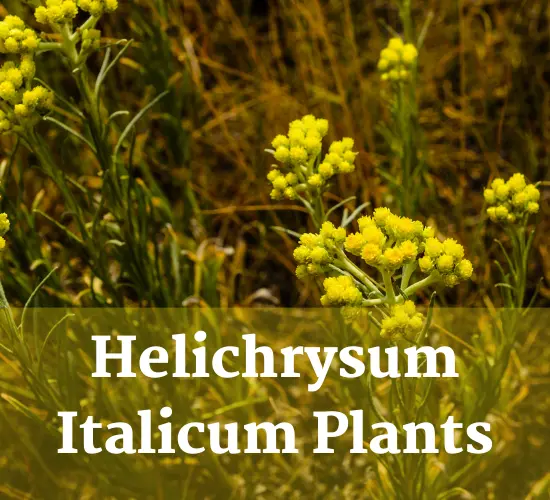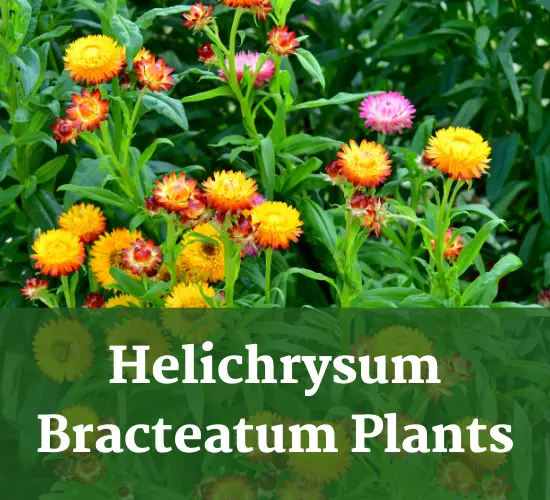Table of Contents
Helichrysum Care
Helichrysum is a genus of flowering plants in the daisy family, valued for their drought tolerance, pest resistance, stunning flowers, and fragrant foliage. With over 600 species, helichrysums grow in a variety of forms, from groundcovers to shrubs. Many gardeners grow these plants for their papery, everlasting blooms and silver or gray-green leaves that thrive with low care and infrequent watering.
In this article, we will provide you with easy helichrysum care tips, ensuring that you can cultivate thriving and flourishing helichrysums in your garden with minimal effort. We will delve into the specific growing conditions that are ideal for this plant, including its preferences for light and water.
What is Helichrysum?
Helichrysum, commonly called strawflower or curry plant, is native to dry regions of Africa, Madagascar, Asia, and Europe. These hardy perennials feature aromatic leaves and brightly colored flower heads that retain their shape when dried. Helichrysums are easy to grow in warm, sunny spots with well-drained sandy or poor soil. Once established, they require little care and tolerate drought, heat, salt spray, and poor nutrients.
Benefits and Features of Helichrysum
Helichrysums offer numerous benefits for gardens, including:
- Drought tolerance: withstand low moisture and dry conditions
- Pest resistance: unappealing to deer, rabbits, and insects
- Flowers and foliage: evergreen or semi-evergreen leaves and long-lasting blooms from spring to fall
- Scent: Gray foliage and flowers emit a curry-like fragrance
The small, clustered flowers retain their shape and color when dried. These textural plants add year-round interest and texture.
Helichrysum Varieties for the Garden
Popular helichrysum species for gardens include:
- H. italicum – curry plant features narrow silver leaves and yellow flowers.
- H. petiolare – licorice plant, has trailing white-woolly foliage.
- H. angustifolium provides vibrant colors and large, papery blooms.
This drought-tolerant genus offers incredible diversity of form, foliage, and flowers. Gardeners will appreciate how easily helichrysums thrive in warm climates with full sun exposure and well-drained, sandy soil. These plants demand little care while adding year-round texture and interest.
Growing Conditions for Helichrysum
Helichrysum thrives in warm environments with plenty of sunlight. These drought-tolerant plants require well-drained soil and infrequent watering once established. Here are the key growing conditions to provide for robust Helichrysum plants.

Sunlight Needs
Helichrysums need full sun exposure for at least 6 hours per day. Choosing a location with a southern or western sun will ensure they receive enough light to flower and grow well. Sunny spots also keep the foliage from remaining wet, preventing disease.
Soil Needs
The ideal soil type is sandy, gravelly, or loamy with excellent drainage. Improve dense clay soils before planting by amending them with compost or small rocks to create pockets for airflow. The soil should have low fertility and be on the dry side.
Watering Helichrysum
These plants are highly drought tolerant when mature. Water newly planted helichrysums regularly until their root systems develop. Then allow the soil to completely dry out between thorough waterings. The lower leaves may wilt slightly but will bounce back after drinking. Take care not to overwater, as soggy soil can lead to root rot.
Temperature and Climate
Helichrysums thrive in hot, dry climates rated USDA zones 9–11. Grow them as annuals in zones 4–8 and bring potted plants indoors over winter. Protect young plants from frost with coverings. Established helichrysums can tolerate short freezing spells with proper mulching. Heat and aridity are more important factors than cold hardiness.
Providing the appropriate growing conditions will reward gardeners with vigorous, carefree helichrysum plants. Their flowers and textural foliage shine when given full sun, well-drained soil, and rare deep watering in hot, dry conditions.
Planting and Caring for Helichrysum
Proper planting and ongoing care ensure helichrysum plants thrive in the garden. Here are tips for getting them established and keeping them vigorous.
When to Plant
The best time to plant helichrysum is in the spring, after the last expected frost. For zones 9–11, fall planting also works well if winter temperatures stay above 25°F. Or start seeds indoors 6–8 weeks before your area’s final frost to give plants a head start on growth. Harden off gradually before transplanting outside.
Planting Process
Choose a sunny location with well-drained soil. Space plants 12–24 inches apart, depending on variety size. Amend the soil with small gravel or sand to improve drainage if needed. Dig holes the width of each root ball and slightly shallower. Carefully place plants, backfill with surrounding soil, water thoroughly after planting, and mulch to retain moisture while roots develop.
Ongoing Care
Weed control is important, as weeds will compete for soil nutrients and water. Apply organic mulch around plants to reduce weeds. Water young helichrysums regularly until they are established, then water deeply only when the soil is completely dry. Shear off spent flower heads and prune lightly in spring to encourage bushy growth.
Pests, Diseases, and Problems
Helichrysums have a few issues, but watch for:
- Spider mites in dry conditions.
- Root rot if overwatered.
- Powdery mildew in poor air circulation.
Overall, helichrysums are quite resilient to pests and diseases with proper cultural care. Their drought tolerance and pest resistance make them easy-care additions to gardens and containers.
Common Problems & Solutions
While generally low-maintenance, hardy plants, Helichrysum can occasionally have issues with pests, diseases, or poor growing habits. Fortunately, there are some easy solutions to remedy these potential problems.

Pests
The volatile oils in Helichrysum leaves, stems, and flowers mean these plants are less bothered by pests than other garden plants. However, aphids, spider mites, or mealybugs may sometimes be a nuisance. Regular monitoring for bugs on the undersides of leaves and gentle hosing with water are typically enough to keep pest populations under control. Their drought-tolerant nature means Helichrysum can handle the occasional drink of water from pest management.
Diseases
Powdery mildew is one fungal disease to look out for with Helichrysum, especially in areas with poor air circulation, shade, high humidity, or crowded plantings. This white fungal growth on leaf surfaces can stunt plant growth but is not fatal. Improve air circulation around plants and avoid wetting foliage to prevent powdery mildew from taking hold.
Fixing Overgrown Plants
If Helichrysum plants become straggly, open, and overgrown, they respond very well to hard pruning in spring or fall. Cut these plants back to 6 inches above the ground, and they will readily regenerate bushy new growth. Their ability to regenerate from old wood makes it difficult to kill these plants through pruning. Just be sure they are established with healthy root systems first before taking drastic corrective pruning measures.
With proper growing conditions like full sun and well-drained soil, providing good air circulation, and monitoring for pests, Helichrysum is generally easy to care for, even with the odd issue. Their resilience and drought-hardy nature mean they will thrive with relatively little attention from most gardeners.
Frequently Asked Questions
How long does it take for Helichrysum Ribbon to bloom?
Helichrysum ribbon typically takes a few months to bloom, but the exact time can vary depending on factors like light, temperature, and care. Growing helichrysum indoors provides the benefit of enjoying its vibrant blooms year-round.
Can Helichrysum be grown indoors?
Yes, helichrysums can be grown indoors as they are adaptable to different light conditions. They make excellent indoor plants for small spaces. Indoor helichrysum care includes providing bright, indirect light, regular watering, and occasional fertilization for optimal growth and stunning foliage.
Are Helichrysums deer-resistant?
Helichrysums are not typically deer-resistant and may be susceptible to deer damage. To deter deer, natural repellents such as garlic spray or planting deer-resistant plants nearby can be effective.
How tall does the Helichrysum Ribbon typically grow?
Helichrysum ribbon typically grows to a height of around 12 to 18 inches. The blooming time for the helichrysum ribbon varies, but it generally starts blooming in the late spring or early summer and continues through the fall.
Can Helichrysum be grown in containers or hanging baskets?
Growing helichrysums in small spaces is possible by planting them in containers or hanging baskets. Helichrysum care in different climates involves providing adequate light, watering when the soil is dry, and regular fertilization for optimal growth.
Is the helichrysum plant toxic to pets?
Helichrysum plants are generally non-toxic to pets. However, it’s always a good idea to monitor your pets around any houseplants and contact a veterinarian if you suspect ingestion or allergic reactions.
What are some common pests or diseases that affect helichrysum plants?
Helichrysum plants are relatively resistant to pests and diseases, but they may occasionally attract aphids, spider mites, or whiteflies. Keep an eye out for any signs of infestation and treat promptly with insecticidal soap or neem oil if necessary. Avoid overwatering to prevent root rot.
How do I propagate helichrysum plants?
Helichrysum plants can be propagated from stem cuttings. Take a 4-6 inch cutting from a healthy, mature plant, remove the lower leaves, and place the cutting in moist potting mix. Keep the soil consistently moist until roots develop.
Why are the leaves of my helichrysum turning brown?
Browning leaves on the Ahelichrysum plant can indicate overwatering, underwatering, or exposure to cold drafts. Check the soil moisture and adjust watering accordingly, and ensure the plant is not subjected to temperature extremes.
How do I fertilize my helichrysum plant?
Feed your helichrysum plant with a balanced liquid fertilizer diluted to half strength every 2-4 weeks during the growing season (spring and summer). Avoid fertilizing during the dormant season (fall and winter).
What kind of light does helichrysum need?
Helichrysum plants thrive in bright, indirect light. Place them near a south or west-facing window where they can receive plenty of sunlight without being directly exposed to intense rays.